Introduction
The goal and charm of being an archeologist of unreality
is to attempt to make sense of the products of imagination.
We apply the rules of the real world, laws of physics, chemistry, biology
and evolution to the creations of film and literature, in an attempt to
make it hang together.
Good writing, good film or movie creations, have depth.
They have psychological reality, and quite often, they can be explained
and understood in terms of reality. Sometimes, of course, something
makes no sense at all, in which case, its far less satisfying. The
point of unreal archeology is to try and wrap reality around things.
It's a game really, but it's a fun game. It's all about making
the impossible possible, about making the unreal plausible, and perhaps
deepening or explaining the underlying mechanics of the work.
What do the religions of Barsoom tell us about the social history of the
world? How do plate tectonics work on a hollow world like Pellucidar?
Things like that.
So, when it comes to the Wieroo, my first impulse is to
dig up Edgar Rice Burroughs cadaver and kick his ass. Because this
takes the cake for being an illogical, insensible bag of hammers.
First of all, there's the question of the basic anatomy.
The Wieroo is a creature with four separate articulated limbs *and* a set
of wings. This is pretty unique among vertebrates.
The other known true flyers, pterosaurs, bats and birds, all work with
a basic four limbs and have converted two of those limbs into wings.
In fact, all known existing and fossil vertebrates from amphibians on up
are confined to a four limb plan. Some, as in cetaceans or certain
flightless birds like the Moa have devolved back to two. Others
like the snakes and glass lizards and certain salamanders have abandoned
limbs entirely. But nevertheless, the basic plan appears to
be rigorously four limbs. However this evolutionary choice was made,
it was made at the very beginnings of the colonization of land by Amphibians,
and it has never been departed from. There is no example on
our Earth anywhere of a six limbed vertebrate species. It's just
not on.
And then there's the improbability of a flying creature
of that size. There's the fact that there are no females only males,
that the males reproduce with other species somehow, and that the offspring
have no apparent heritage from the mothers. It's just impossibility
piled on top of contradiction on top of nonsense. I'm not happy.
So, let's set to seeing if we can make some sense out
of this creature. At the outset, I acknowledge a debt owed
to Rik Johns, whose detailed descriptions of the Wieroo and URL appear
in the appendices.
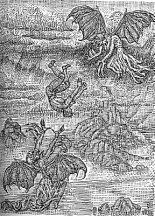 .
.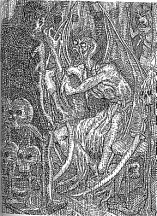
Wieroo Art by Mahlon Blaine
Extraterrestrial?
A refugee from Barsoom?
Perhaps the Wieroo are extraterrestrial? Well,
that would be a handy way of getting out of any jam. Your creature
is a bit weird? It's obviously from off world, no need to try
and construct an evolutionary history or taxonomy, its just from somewhere
else. It's a cheap cop out, and frankly, its not nearly as
interesting a solution.
To be fair though, one has to acknowledge that six limbed
creatures, Apts, Green Men, White Apes, form an important part of the ecology
of Barsoom. Further, on Thuria (likely a Barsoomian colony),
there is a small six limbed bird, with four legs and two wings.
So it's possible that the Wieroo might be a transplanted Barsoomian evolutionary
line.
The problem here, of course, is that there's no evidence
that Barsoomian life forms ever managed to reach Earth. John
Carter and Ulysses Paxton can astrally project themselves back and forth,
but this is a talent seemingly reserved to humans.
Related Species, The Trodon
So, what do we do with our frustrating Wieroo?
Well, the next step is to peruse the rest of Burroughs canon to see if
there is anything similar. The Wieroo alone pose a problem.
But another similar creature means that we can identify their commonalties,
dissect their differences and work backwards to a common ancestor and an
evolutionary pathway.
So, are the Wieroo alone
on Earth? Not quite.
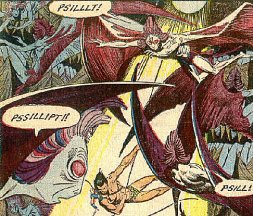 For one thing, the Wieroo, in a quasi-canonical story, appear to have cousins
in Pal Ul Don. They were chronicled in a Tarzan comic strip
done by Comics legend Russ Manning. There is a description and URL
in the appendices.
For one thing, the Wieroo, in a quasi-canonical story, appear to have cousins
in Pal Ul Don. They were chronicled in a Tarzan comic strip
done by Comics legend Russ Manning. There is a description and URL
in the appendices.
However, as interesting and instructive as it is, this
is not canonical. At best, we can accept them as a sub-race
of Wieroo. But we shouldn't build our edifices too high on those
backs.
In Pellucidar, there is a very interesting animal called
the Trodon, described as follows:
“The trodon is somewhat
pterosaurian, having a head that is "pterodactyl-like", and mighty
leathern wings. Its' body, however, somewhat resembles a gigantic winged
kangaroo, with powerful rear legs, and a massive tail. Its forearms are
separate from the wings, and with them the trodon can easily grasp its
prey. It also has a pouch with which it transports its victims (and perhaps
its young, after they hatch?). The trodon paralyzes its victims'
nervous system with its barbed tongue. The victims are then left in the
adult trodon's rookery until the eggs hatch, and the young trodons devour
their screaming victims alive.”
Again, there is a more elaborate quote, and a URL which also
includes artists depictions in the Appendices. The Trodon is
the only other distinct animal which shares the Wieroo body plan of four
legs and a pair of functional wings. It is almost certainly
related.
Now, all by itself, the Trodon would be a puzzler.
It's described as a marsupial reptile, or a reptilian marsupial.
Like Marsupials, it has a pouch, which would suggest that it is fundamentally
a mammal. Like reptiles it lays eggs. So, in this respect,
it's a toss up.
It may well be a reptile which has evolved a pouch, much
like Marsupials did. On the other hand, the monotremes of Australia,
such as the pangolin and platypus lay eggs. So it's possible
that the Trodon’s line is derived from very early egg laying monotreme/marsupials.
The overall body plan, except for the wings and head is
expressly that of a Kangaroo. On the other hand, that body
plan is also used by carnivorous biped dinosaurs. So, once
again, its hard to tell.
The pterodactyl like head is suggestive of reptilian origins,
but then again, it wouldn't be out of the question for a mammalian muzzle.
So, we could go either way.
We could stop to wonder if Trodon's are warm blooded.
The Wieroo seem to be, and the high level of activity and complex behaviour
of the Trodon would seem to lead us in that direction. Marsupials
are warm blooded, but monotremes have aspects of cold bloodedness.
Reptiles are cold blooded, but there's evidence for warm blooded dinosaurs.
Generally, the Wieroo seem less ambiguous and more clearly mammalian, which
suggests the Trodon is too.
Meanwhile, there are features to the Trodon, such as the
barbed tongue which seem to fit nowhere.
In the end, it becomes almost a coin toss as to whether
the Trodon, and by extension, the Wieroo are reptiles or mammals.
My instinct is to call them marsupials for now, but its an issue we'll
keep wrestling with.
So, now we have two related creatures, what can we make
of them?
Flying Dragons Down Under
First, I think that we can begin to identify their common
geographic origins: Australia, or perhaps Antarctica.
After the fall of the dinosaurs, Australia, Antarctica (before glaciation)
and South America were lost ‘Island continents’ were marsupials thrived.
In South America, the marsupials were accompanied by lively lines of placental
mammals. But in Australia, the placental mammals never made
it at all, and the entire continent was left to egg laying monotremes and
marsupials. Thus, Australia isolated earlier than South America,
and represents the better candidate for our Wieroo/Trodon ancestor.
Antarctica is a big blank spot, since all of its mammals
are long extinct and its fossil record is buried under miles of ice.
But charitably, I would include Antarctica as a repository of lost and
unknown marsupial and monotreme mammals.
So, let's go back to our central headache.
The four legged and two winged character of the Wieroo and Trodons.
As I've said, every vertebrate beyond fish works on the four limbed plans.
Once in a while, fewer. Never ever more.
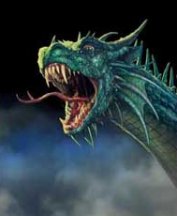 Is there any way around this? There is a precedent.
The flying lizard Draco has two wings in addition to its four legs.
How does it manage this? Very simple, the ‘wings’ are not limbs,
as in birds, bats and pterosaurs. Rather, the ‘wings’ are modified
ribs, stretched out and elongated from the body, with leathery skin between
them. Draco is a tiny lizard, perhaps eight inches long with
a six inch wingspan.
Is there any way around this? There is a precedent.
The flying lizard Draco has two wings in addition to its four legs.
How does it manage this? Very simple, the ‘wings’ are not limbs,
as in birds, bats and pterosaurs. Rather, the ‘wings’ are modified
ribs, stretched out and elongated from the body, with leathery skin between
them. Draco is a tiny lizard, perhaps eight inches long with
a six inch wingspan.
Right now, Draco is the only animal which has evolved
this particular approach to gliding flight. But it is not alone.
The fossil record shows us Coelurosauravus, a pre-mezosoic lizardlike creature
which existed in Madagascar, sixteen inches long with a ‘wing’ span of
a foot. There was also Kuehneosaurus, with a length of 26 inches
and a wing span of over a foot, which lived in the late triassic in England.
None of these creatures could actually fly. Rather,
they were all gliders. But nevertheless, they managed to grow
a pair of wings without actually having to give up four limbs.
Could one of these reptiles be the ancestors of the Wieroo
and Trodon? It's possible, but unlikely. While
the Trodon has some distinct reptile characteristics, they are notably
dinosaur/pterosaur traits. Our little flyers were all lizards or
lizard like creatures, they were an evolutionary side line to the higher
archosaurs.
The trouble with these little guys, is simply that they
were too handicapped to break out of their niches. They're small
cold blooded, relatively primitive insectivores. Those reptiles
who were going to make something of themselves, had already separated and
were in the process of becoming dinosaurs and other higher reptiles.
This was a development among the reptilian also rans, a wrinkle among creatures
that had already been bypassed. Ultimately, they are evolutionary
dead ends.
Not that there's anything wrong with evolutionary dead
ends. The lizards may not have been great shakes, but in the
end, they've outlived the dinosaurs by some 65 million years. So
who is laughing now. But the point is that for various reasons, like
the inbuilt limitations of these lizards, the problems of competition,
the need for major mutation, the winged lizards simply were not capable
of making the leap to the big time.
What they really tell us, is that it could be done, which
opens the door to speculating that some more advanced species tried the
same trick. This has happened before. Take
the sailbacks. In the Permian, there was a sailbacked mammal like
carnivorous reptile called Dimetrodon. It basically looked
like a monitor lizard with a big sail on its back made of elongated vertebra
spikes. It was used to regulate body heat. Not to be
outdone, there was a vegetarian sail backed reptile, called Edaphosaurus,
which looked like a big iguana, and independently arrived at the same solution.
Fast forward a hundred million years, and we have a couple
of new sailbacks. The new one was a T-Rex cousin named spinosaurus,
and a duckbill dinosaur cousin named Ouranosaurus. There was no direct
evolutionary connection between any of these four. It was simply
a good idea for the circumstances.
So, if the primitive draco lizards could develop ‘rib-sail
wings’, then its entirely possible that some later and more advanced species
might be able to do the same thing.
A dinosaur? Unlikely. The dinosaurs
had priced themselves out of the market. Although they were sophisticated
and advanced reptiles, they were too strongly committed to their lines,
and to the larger size ranges. To get to that viable ‘rib-wing’,
you would need to start with a small, even tiny, tree dwelling, generalized
creature. There were no dinosaur lines like that.
Marsupial Dragons?
Mammal lines? Yes. Hell, for millions
of years, that was nothing but the mammal lines. Small, covert, agile,
active tree climbers, the prehistoric analogues of rats and squirrels.
They were perfectly positioned in the trees to begin this line of development.
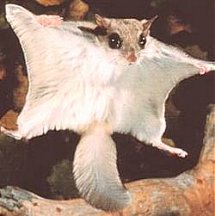 In
fact, many mammalian tree dwellers became gliders. There are
a half dozen independent variations on the flying squirrel, including a
marsupial version. Essentially, they achieved a limited gliding
by stretching membranes of skin out between their limbs and parachuting
along. So why didn't we see rib-wings among mammals?
The simple explanation that the flying squirrel type skin membrane was
just a quicker and easier evolutionary fix. After all, to get
rib wings, you've got to separate the ribs from the body, grow them out,
hold them steady and stretch skin across them. For the ‘flying
squirrels’, all you had to do was stretch a membrane between your forelimbs
and hind limbs and you were in business.
In
fact, many mammalian tree dwellers became gliders. There are
a half dozen independent variations on the flying squirrel, including a
marsupial version. Essentially, they achieved a limited gliding
by stretching membranes of skin out between their limbs and parachuting
along. So why didn't we see rib-wings among mammals?
The simple explanation that the flying squirrel type skin membrane was
just a quicker and easier evolutionary fix. After all, to get
rib wings, you've got to separate the ribs from the body, grow them out,
hold them steady and stretch skin across them. For the ‘flying
squirrels’, all you had to do was stretch a membrane between your forelimbs
and hind limbs and you were in business.
At least one line of prehistoric ‘flying squirrels’ eventually
evolved into bats. This was a placental mammal, which probably
originated in the old world, and then eventually spread to all the continents,
including Australia and South America. But while the Bat was
developing and getting its act together, the skies of Australia were vacant,
and there was a window of opportunity for marsupials to develop their own
flyer. And they may have had the biological flexibility to
use develop rib-wings.
 And Australia had a tendency, sometimes, to do things in weird ways.
Unconvinced? Take a look at the Duckbill Platypus or the Pangolin.
Or think about this: The Kangaroo was Australia's attempt to
make a Deer. It's entirely possible that an Australian tree
shrew, for one reason or another, found itself doing things the hard way
and developed rib-wings. There may have been some genetic quirk
or local condition that worked against the usual solution.
And Australia had a tendency, sometimes, to do things in weird ways.
Unconvinced? Take a look at the Duckbill Platypus or the Pangolin.
Or think about this: The Kangaroo was Australia's attempt to
make a Deer. It's entirely possible that an Australian tree
shrew, for one reason or another, found itself doing things the hard way
and developed rib-wings. There may have been some genetic quirk
or local condition that worked against the usual solution.
So, our first step would be some marsupial squirrel, or
more likely a marsupial insectivore similar to a tree shrew developing
draco type rib-wings. This would make it a superior glider to the
normal flying squirrel designs. As a sophisticated glider,
it would develop as a predator. All it would have to do would
be to climb up high, keep an eye open for prey and then drop, gliding onto
the pray from above in an ambush. The ability to control the glide
with the rib-wings would mean that they could adjust course and even overcome
evasive maneuvers should the prey spot them and attempt to dodge.
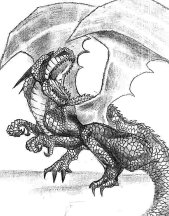 And
by the way, this knocks Antarctica out of the running.
For these evolutionary developments, you need a thick rain forest jungle.
Australia, at tropical and subtropical latitudes had that.
Antarctica, on the other hand, even before it moved into its polar position
and became ice covered, was much further south in temperate zones.
It didn't have rain forest jungle, but at best, boreal forest and plains.
So, our Marsupial Draco is an Australian.
And
by the way, this knocks Antarctica out of the running.
For these evolutionary developments, you need a thick rain forest jungle.
Australia, at tropical and subtropical latitudes had that.
Antarctica, on the other hand, even before it moved into its polar position
and became ice covered, was much further south in temperate zones.
It didn't have rain forest jungle, but at best, boreal forest and plains.
So, our Marsupial Draco is an Australian.
This advantage in hunting would lead to certain evolutionary
developments. Our marsupial draco would graduate from insectivore
to predator, becoming larger. It would prey upon other small
ground or tree dwelling marsupials, a local ‘death from the sky.’
Evolving the Wieroo, Faces,
Legs and Wings
Getting larger would mean that our marsupial draco would
need to evolve larger and better wings, it would need stronger and better
muscles and ligaments to control its glide. This would set it on
the path to true flight.
It would also result in certain adaptations.
Like eagles or owls, the hunting birds, its vision would have to improve.
The eyes would become larger and more acute. If it was a nocturnal
hunter (and night gliding or flying was virgin territory waiting to be
occupied, most birds were not night flyers) then again, the eyes would
have to become larger and more acute.
Ambushing prey from above requires excellent depth perception,
which requires binocular vision. The face of our marsupial tree shrew
would have shortened like a cats, the head becoming wider, the eyes looking
forward. The result would start to be a pterosaur-like head,
and the line that will lead to the Trodon.
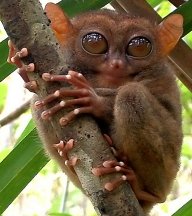 Or,
given the extra demands of nocturnal existence even flattened as we see
with Owls and Tarsiers. Owls need bigger eyes than Eagles because
they are nocturnal predators. This has resulted in startling flat
faces. The Tarsier is a nocturnal lemur-like primate, but unlike
other lemurs who have dog like muzzles, the Tarsier needs excellent nocturnal
depth perception to jump from tree to tree, hence a flat, oddly human-like
face. Your creature, some varieties of it, perhaps the line
that leads directly to the Wieroo will start to look like flying monkeys.
Shades of the Wizard of Oz!
Or,
given the extra demands of nocturnal existence even flattened as we see
with Owls and Tarsiers. Owls need bigger eyes than Eagles because
they are nocturnal predators. This has resulted in startling flat
faces. The Tarsier is a nocturnal lemur-like primate, but unlike
other lemurs who have dog like muzzles, the Tarsier needs excellent nocturnal
depth perception to jump from tree to tree, hence a flat, oddly human-like
face. Your creature, some varieties of it, perhaps the line
that leads directly to the Wieroo will start to look like flying monkeys.
Shades of the Wizard of Oz!
Very quickly, our marsupial draco, by the time its about
the size of a crow or raven, would come to a problem: Its wings
were not very efficient.
They're excellent gliding wings, no question.
Difficult to develop, but once you've got them, you're far superior to
those pokey flying squirrels. But for powered flight?
Not so good.
The problem is that bats, birds and pterosaurs were using
wings that were adapted forelegs. These were already designed as
load bearing structures, capable of rapid movement and dealing with heavy
stresses. They were already wired into an evolved musculature,
and hooked up to big heavy muscle groups. It would take some
heavy engineering to turn them into wings, but at the same time, the basic
architecture was already highly developed.
In contrast, the rib-wings had relatively minimal musculature
to start with. The ribs had not originally developed as flexible
load bearing structures anchoring major muscle groups. So you weren't
going to get as large, or as heavy, muscle arrangements as we found in
birds and bats. Worse, you were going to have to get around the fact
that your wing muscles would be putting stress on the torso, and that your
torso was structurally a few ribs short. The result was underpowered
wing muscles, and birds and bats literally flying circles around you.
Now, in the early days of Australia, this wasn't a big
deal. Birds were strictly daytime animals, so the night was
their territory. Bats hadn't evolved yet, or hadn't reached Australia,
so there was no competition for the night. The Marsupial Draco
was free to evolve in peace. Of course, when bats did start to arrive
to take over the night, the Marsupial Draco was in trouble!
So, what could the Marsupial Draco do? Well,
it wasn't out of the question that Marsupial Draco could develop powerful
wings. Given enough time, that could be evolved.
The trouble was that birds and bats had a built in head start.
But there was another solution available.
Jumping like a little kangaroo. Gliding animals have always
leaped to begin their glide. Flying fish take that a step further
by literally jumping out of the water to glide, their leap provides the
momentum for the glide. Essentially, its almost flight by launch.
This wasn't an option available to most birds or bats,
they'd already pledged their musculature to their wing structures, and
they couldn't really engineer powerful jumping legs. Bats in
fact, were so committed to winged flight, that they almost lost the ability
altogether to run on their hind legs. For both bats and birds, the
hind legs were used heavily for perching and resting. It also wasn't
an option available to ‘flying squirrel’ type gliders, whose legs were
anchors for the gliding membranes. But for the Marsupial Draco, the
legs and their musculature, were free and clear.
So, in order to make up for a lack of power during flight,
the Marsupial Draco, began to evolve launch power. Essentially,
powerful jumping legs would provide the initial acceleration.
Assuming that our Marsupial Draco concentrated on short flights and made
a point of aiming toward and kicking off from tree branches and trunks,
it could fly quite well and compete with bats and birds. It
was still an inferior flyer, but at least it could stay in the game.
So, what this starts to mean is relatively large and long
hind legs, in comparison to the front legs, which are proportionately shorter.
Essentially, we saw a move towards the kangaroo like proportions of the
Trodon, and the human-like proportions of the Wieroo. In short, the
die is cast, and the evolutionary pathways to Trodon and Wieroo are now
clear.
There's room for debate of course. When did
the Trodon and Wieroo lines split? Late or early? At
the very least, the critical adaptations were well established by the time
the split occurred. Were the adaptations made in isolation,
or was the competitive pressure of birds and especially bats a factor?
And when did it become a factor? And for what adaptations?
Trodon and Wieroo Split
There were a few little wrinkles. Obviously
a short faced, flying predator has a few handicaps in ambushing its prey.
Eagles and Owls have developed formidable talons, bats on the other hand,
have largely stuck with insects and small prey. How was the
Marsupial Draco to subdue its prey. Its front and back paws could
develop claws, but these were needed for tree climbing, so they could never
be hyper-specialized weapons. The shorter flatter faces made biting
attacks more difficult.
A solution was a poison barb. Poison is mostly
restricted to a few reptiles and amphibians. But there are actually
poisonous mammals, although its rare, and mostly found among shrews.
But it is available to mammals to develop.
The development of the poison barb attack probably set
the Trodon on its path to becoming a major predator, and oriented it strongly
towards predator specializations like claws and talons. It became
the big game hunter, going after animals its own size and larger.
Without the poison barb, the Wieroo line could not hunt
as ambitiously. They were forced to pursue smaller prey.
This meant that in order to make their meal, they could not rely upon the
big fat kill, but had to make many smaller kills of smaller, faster, more
cunningly concealed prey.
This fostered the development of intelligence in the Wieroo,
as well as increasing the requirements for detailed vision.
A Trodon, or Trodon ancestor simply had to watch for a cow or a deer blundering
along, easy to spot, easy to fall upon and a very rewarding kill.
The Trodon didn't need hyper-acute vision, so its head did not flatten
past pterodactyl levels. The intelligence remained relatively low
and animalistic. The adaptations were devoted to helping to kill
and devour large prey. And of course, the large amounts of
meat, relatively easily caught, resulted in it becoming an increasingly
large predator.
For the Wieroo ancestor, there was a need to carefully
study its surroundings, looking for subtle telltale signs of spoor, dens,
nests or tracks. It had to be able to distinguish between leaves
shifted by the passage of prey, and that of movement. It had
to figure out what prey was around, where it was to be found, and when
it was most likely to be caught. And of course, instead of
one big kill, its dinner was likely several different types of prey.
This would foster the development of intelligence, even as the enlarged
nocturnal eyes made the face almost flat. Because the prey was small
and helpless and relatively easily devoured, heavy muscles, powerful jaws
and ripping talons were not necessary and did not develop. On the
other hand, the Wieroo had to work a lot harder for its dinner than the
Trodon. The Trodon could afford the luxury of a heavy kangaroo
tail, the Wieroo could not. The tail diminished, becoming a
slender appendage or vanishing entirely. The separation of
the two lines was complete.
At this point, by the way, we're probably not all that
big. The Trodons are the size of small dinosaurs and the Wieroo
are human sized. But realistically, in comparison to other
flyers, its unlikely that the proto-Wieroo got any larger than monkeys,
or the proto-Trodons got any larger than Eagles or Vultures.
It was probably only in Pellucidar that the modern forms reached their
present sizes.
And inevitably, the proto-Wieroo and proto-Trodons moved
to Pellucidar. In their original homeland of Australia, they were
eventually overwhelmed by changing climate and the competition of bats
and birds.
Trodon and Wieroo Reproduction
There are only a few things left to clarify now.
One is reproduction. Obviously flying creatures need to keep
their weight down. A flying marsupial, particularly one with
under-powered wings, has a problem. The demands of flight meant
that both lines would have to wrestle with the problems posed by carrying
infants.
For the Trodon, this meant a return to egg laying, not
too far past in its evolutionary history. The pouch remained
and became a means of carrying food, much like a Pelican's pouch.
The Wieroo's evolutionary solution was almost diabolical
in its elegance. The Wieroo became a cuckoo. Instead
of raising its young itself, it simply passed the job onto some other animal.
To understand how this works, we have to come to grips
with the apparent strangeness of Wieroo sex. According to those
familiar with them, the Wieroo are exclusively male, an obvious impossibility.
Even worse, they use other species females to reproduce, a double impossibility.
And finally, the offspring of these impossible unions, seem to have no
genetic relationship to their mothers, but are completely Wieroo, a triple
impossibility.
Okay, reality check here. Obviously, the Wieroo
must have male and female sexes. Every vertebrate has that.
However, the distinction between male and female Wieroo may not be obvious.
The Wieroo, remember are not even off of a primate line, they would not
have human sexual or secondary sexual characteristics. In fact,
female sexual characteristics may mimic and even exceed the male's organs.
The spider monkey female, for instance, has a long pendulous clitoris which
may be mistaken for the male penis. The female Hyaena's
clitoris is a huge organ resembling but larger than the male organ, and
the female Hyaena goes it one better by sporting a large, false testicle
sack. Ancient writers were baffled by the fact that Hyaena's
seemed to be exclusively male and could not understand how the species
could reproduce. The Wieroo are similar to Hyaena's and Spider
Monkey's in that the female anatomy is difficult to distinguish from the
male.
But how does this deal with their need to impregnate human
females? To understand this, we have to appreciate a peculiarity
of Marsupial reproduction. Placental mammals are kept within
the mother's body for an extended time, and are born relatively fully developed.
Within hours of birth, an infant calf is walking around. Within weeks
a kitten is playing.
Marsupial mammals on the other hand are born almost completely
undeveloped. A baby kangaroo at birth is almost microscopic.
The Marsupials are born undeveloped and move into the pouch where they
are sustained by milk and finish the rest of their development.
Well, as we've noted, a flying marsupial cannot really
afford the extra weight of a developing baby, so they have to get them
out of the pouch. The Trodons dealt with that, as we noted,
by laying eggs. The Wieroo solution was even more ingenious.
They placed their offspring in other animals to grow!
Among vertebrates, there are examples of mother animals
adopting or suckling other species. The cuckoo bird takes this
a step further. It lays its eggs in another birds nest. The
cuckoo's are born larger and stronger than the original inhabitants of
the nest and quickly dispose of them. Thereafter, the mother and
father birds of the nest feed and raise the cuckoo as their own.
Now, Marsupials young are born almost microscopically
tiny. So, it would be feasible for the Wieroo to insert their
young, while microscopically tiny, into a suitable host and let it grow
there.
The Wieroo's, in a Marsupial world like Australia, were
originally simply cuckoos. Instead of planting their eggs in another
birds nest, they planted their offspring in another marsupial's pouch.
This would tend to evolve a specialized ‘planting’ organ, and would undoubtedly
be traumatic to the host marsupial. But a few months later,
the host would not be connecting its traumatic experience with the loved,
if strange, baby in its pouch.
The shift of Wieroo populations to Pellucidar would have
introduced them into a world filled with placental mammals which far outnumbered
marsupials. This would offer them an opportunity to take the
next step, to shifting from planting in the pouch of Marsupials, into the
actual bodies of placentals.
The Wieroo young probably attaches itself to the tissue
of the host parent, devouring the flesh or sucking the blood.
Or it might actually be able to ‘trick’ the Mother's body into a state
of false pregnancy, causing a placental membrane and umbilical cord to
grow around itself. In this case, the host mother would
carry the Wieroo as if it was their own baby. The Wieroo young
would grow and eventually emerge from the body of their host mother, but
would have no genetic relationship to the host mother.
Thus, we now know who and what the Wieroo females are.
They're
the ones ‘raping’ and ‘impregnating’ human women. The
males, in contrast, are probably less robust and less aggressive.
Evolution and Wieroo Society
The Wieroo evolved intelligence much like primates, in
order to meet similar conditions, but with very different driving factors.
Primates, who essentially evolved intelligence as way
of mapping out the forest, determining what fruit trees there were, where
they were, and when each was in season, had a very important difference.
For them, food, when available, was plentiful. After all, on
any fruit tree in season, there would be far more fruit than any one monkey
could eat before it rotted. So, monkeys congregated, their
intelligence became a social intelligence. They moved and lived
in groups, and refined their intelligence by evolving as a social animal,
developing ways to manage conflicts, systems of dominance and submission,
relationships, alliances and affection.
The Wieroo were ‘small creature’ predators. They
weren't looking at fruit trees where there was enough for all.
For each Wieroo, the objective was to find enough for itself. Which
meant that any other Wieroo hunting in the neighborhood was a potential
competitor. They felt no need to be social.
Unlike big game hunters, there was no need to cooperate.
Instead, the Wieroo simply went their own ways.
Did the Wieroo gather? Of course they did. After all,
when not hunting they needed to rest, to sleep, they needed shelter, they
would seek the same sorts of areas, require the same sorts of resources
and refuge. So, much like seagulls, they would
tend to congregate on secure areas.
But the social evolution of Wieroo groups, and the evolution
of their social wiring, was much different from Monkeys and Primates.
Troops of Monkeys formed a community with common direction and common purposes,
individuals behaviour is dictated by their relationships with other individuals
in the troop.
A congregation of Wieroo was just a collection of individuals,
without any more complex interrelationships or common purposes.
The behaviour of an individual Wieroo was dictated, not by relationships
with other individuals, but by the strength and prowess of that individual
against others.
So, when a Wieroo builds a house, its choice is dictated
by its ability to impose itself on the others around it. Which
could include using other houses as walls, or even as building materials,
or building its house on top of another house. There is no
concept of planning or order. Status among Wieroo is determined
not by relationships, but by acts, including acts of Murder. A Wieroo
City thus, is a lot closer to a Seagull breeding rookery, both in structure
and social organization, than it is to a human city.
This doesn't mean that Wieroo have no capacity for social
relationships at all. It's clear that they murder each other
freely, treat each other as slaves and have almost no interest in their
children. Nevertheless, they have evolved some basic degree
of cooperation in being able to endure in a city or colony at all.
They are intelligent enough to recognize common purposes, and if the reward
is close, they can work together. They can appreciate cooperation
through enlightened self interest, including bargaining and exchange, where
there is not enough strength to simply take. Males and females
probably bond. And the need to find and control host mothers for
their reproduction probably drives some social cooperation and organization.
But Wieroo social wiring, their social evolution and social behaviour is
quite different from primates and markedly less advanced.
It is likely that one major driver of social behaviour
and Wieroo society is the need to find, control, and care for host mothers.
At least, so long as those host mothers are useful for reproduction.
Host mothers are the equivalent of big game, so they may work cooperatively
to hunt and trap them. Host mothers must then be controlled or the
babies may not survive. Controlling them means confining and feeding
them. Which means that the demands on a Wieroo's time and energy
grow dramatically with every host mother acquired. One way
around that trap is to try and force the slaves or host mothers to earn
their own keep. Another way is to enlist other Wieroo in feeding
and caging your host mothers, either through your own strength and willingness
to murder them, or by bargaining status, resources or access to host mothers.
One activity which almost certainly resulted in the development
of social behaviour would be fishing. Fish are the one small
prey that are plentiful like fruit, thus eliminating competition, and which
are best hunted cooperatively like big game, thus encouraging cooperation
and teamwork.
It is no surprise that the Wieroo Cities are on an island
in a lake in Caprona. It is likely that the subsistence economy
of these cities is based principally on fishing. (There is
probably little or no significant agricultural economy) Of course,
the increased technology of the Wieroo, through use of tools, spears, hammers
clubs and nets, now allows them to go after big game which was formerly
beyond their physical capacity, which also encourages cooperation.
Thus, we see a big difference between Wieroo and Hominids.
Hominids were social before they became tool users. Wieroo
becoming tool users allowed them to become social.
As tool users, the Wieroo are no slouches.
It is clear that the high degree of intelligence developed in evolving
as a small prey hunter allowed them to develop increasingly sophisticated
tools, including eventually metalworking and weaving. This
is not surprising, Otters and Eagles will use stones as hammers to break
open shells, the early Wieroo started from there and never looked back.
It is not clear that the Wieroo developed language on
their own. At best, they might have developed some capacity
and simply borrowed language from humans. If they did have
language, it likely developed on extremely narrow lines. Wieroo
language is probably heavily oriented towards nouns and naming, and stating
intentions and acts. Wieroo language is likely ‘me’-centric
and not really concerned with abstracts, philosophy or other viewpoints.
Wieroo behaviour is likely heavily influenced by instinctive
behavioural wiring. The behaviour of house building, for instance,
seems heavily reminiscent of the instinctive drives to build nests or bowers,
including elaborate structures, in some birds and mammals.
In particular, the penchant for using skulls as a building material is
highly reminiscent of the attraction of magpies and other birds to find
and incorporate shiny or bright object in their nests to make it attractive
to potential mates.
Despite their intelligence and technological ability,
the Wieroo social handicap has prevented them from dominating or ruling
Caprona. They simply cannot cooperate or establish a social
structure as complex as a systematic Empire.
Wieroo Outside Caprona
The Wieroo and Trodon, and the evolutionary lines that
lead to them, are long extinct in Australia. The Wieroo
of Caprona are likely an outlier population derived from Pellucidar.
The fact that beings so large can fly at all suggests that gravity and
air pressure are more benign in Pellucidar, and that Caprona is well within
Pellucidar's gravitational and atmospheric conditions.
There is some indication of a population of Wieroo in
Pal Ul Don, although this report is apocryphal. The Pal
Ul Don Wieroo differ from Caprona Wieroo in that they are tailed and can
use their tails for peacock display, have prensile feet and spurs on the
feet, and it is not clear whether they have a language. They
display technological and social sophistication, including nests, weapons
and breeding arrangements, but not too the level shown by Caprona Wieroo.
None of these things would be out of line for Wieroo development, and in
fact, Wieroo may speciate heavily, there may be dozens of varieties of
Wieroo in Pellucidar.
According to Caprona informants, the Wieroo practice natural
selection by infanticide, and so it is entirely possible, even likely,
that the Wieroo will tend to select infants for resemblance to the dominant
population in the area. This may simply be good sense, a tailed
Wieroo born to a tailed mother is less likely to be rejected or killed
by the mother. The same holds true for a tailless Wieroo born to
a tailless host mother. Or it may be that Wieroo, in absorbing language
from their human or human-like neighbors, also absorb aesthetic judgments.
It is likely, given their handicaps, that the Wieroo of
Pellucidar are a series of scattered populations. They would not
be able to compete with organized human cities or states. They likely
exist as individual loners, in small pack-like groups in wild territories,
and in cities/rookeries/colonies in secure locations like offshore islands.
And that's the Unreal Archeology of the Wieroo, one of
Burroughs strangest creatures. An exotic Australian Marsupial
creature part hominid, part predator, part flyer.
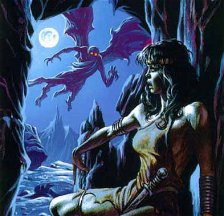
APPENDICES
Caprona, Wieroo Descriptions and Society
http://panthers.pnc.edu/sphill01/caspak.htm
One other race is native to the island, an entirely fictitious
one invented by Burroughs. These are the Wieroos, a race of winged humans
that consists entirely of males. They have dead-white skin, and goggling
eyes, which lends them an eerie death-like appearance. They can see in
darkness as well as a cat. It is uncertain entirely bizarre race came about.
The Wieroos seem to regard themselves as the highest race on the island,
but they seem to have originated, not from the Galu, but through some freakish
off-branching in the Caspakan chain of human evolution. The Wieroo exist
on an island in the center of a lake, in a city constructed entirely from
human skulls. They prey on the women of Caspak's human races. The young
born to female captives of the Wieroo is always male, showing no characters
of their female parent.
http://www.geocities.com/RikJohnson_ERB/caspak.html
Much of what we know of this race comes from the diary
of Bradley and his Ga-lu wife as they were imprisoned on this island. However,
Co-Tan's comments were based on oral legends of a race that they considered
to be almost supernatural and Bradley's time among the Wieroo was limited
to a very few days. Thus the information given is suspect.
However, we can make a number of suppositions that may or may not be accurate.
Legend shows that the Wieroo (Weir-lu?) and Ga-lu races
evolved at the same time and under similar conditions. The Weir-lu race,
however, possessed rudimentary wings which gave them a monumental ego as
well as a goal in life. By kidnapping Ga-lu women as breeding stock
and by killing their own children who were born with smaller wings, the
Wieroo race quickly controlled their own evolution and became a truly avian
race. Their physical appearance eventually changed into one of hideous
visage being hairless with flat ears, claws instead of nails and large
wings and eyes. Wieroo prefer to travel at night, possibly because
of their eyes, which are night-adapted and therefore sensitive to daylight.
The Wieroo mentality is that of advancement by murder,
a philosophy that they attempted to export to the Ga-lu with no success
and so were driven to the island of Oo-oh where they managed to develop
a civilization of some advanced technology, the most obvious being the
smelting of iron ore into sabers and the weaving of cloth, neither of which
are possessed by the Ga-lu. Despite this technical advantage and their
vast numbers, the Wieroo have been unable to conquer the less-technical
and ground-bound humans.
Currently Wieroo are denied weapons until the secretly
murder sufficient numbers to enable them to wear a red slash across their
white robes. As the numbers of their victims increases, so does the colour
of their robes, eventually earning them the right to bear arms, after which
murder becomes easier and advancement quicker. The ultimate
murderer will eventually become the king of the island.
The Wieroo steal women from the neighboring Ga-lu tribes,
bringing them to their island where they are hidden away and forced into
a lifetime of servitude as breeding stock. Until the O’Brien expedition
of the 21st century, the Wieroo were considered to be invulnerable and
none of their captives (save Bradley and Co-Tan some 80 years earlier)
had ever escaped.
One question that remains unanswered is why the U-33 submarine
which brought Tyler and his party into Caspak was not used to shell the
Wieroo city and rescue the Ga-lu captives. Since all members of that expedition
have been dead for decades, we may never know the answer.
It is believed that as the number of female Ga-lu prisoners
cannot possibly meet the needs of the Wieroo nation, that the majority
of the Wieroo are unarmed celebates who are forced to live on the outskirts
of their cities as virtual slaves. These continue in their drab lives until
they manage to murder their way up the social and political ladder and
also inward to the center of the city.
Those who are successful in capturing a Ga-lu woman must
keep her in secret and as she bears him children, he then drives these
sons away as they reach puberty. These abandoned children migrating to
the slums of the city outskirts until they are able to murder their way
back to the center of the city.
When a Wieroo murders another, he searches the home of
his victim for wealth, skulls which are trophies of his kill and, of course,
the hidden rooms in which his victims are secreted. The successful murderer
then kills the children of his victim and takes their captive mother for
his own. The growth of the city is as interesting as the political
climb of the citizens.
Each Wieroo city, of which there are three, is built upon
a river that provides drinking water, a sewer and a means of disposing
of their murdered victims. The city starts as a series of regular buildings
that line the river. As the population increases, roads are built and more
homes are constructed along a set grid pattern with bridges to cross the
river. Up to this point, the construction is normal and predictable. However,
at a certain point, the society breaks down for unknown reasons.
One theory is that those who regulate the city plans are
murdered, thus allowing unplanned construction to take place but this is
unproven.
Regardless of the reason, the inhabitants begin to construct
more buildings at random. One can imagine an up-and-coming star on the
political scene abandoning his hovel on the outskirts and moving inward
as he murders his way up the social scale. Seeing a street with two buildings
on either side, he decided to take advantage of this and rather than build
four walls and a roof, he builds two walls that cross the street and connect
the two original buildings. He then roofs his new home at a considerable
savings in cost, materials and labour. The fact that the road is now blocked
by his new home is irrelevant as the Wieroo can easily stop walking and
fly over the obstacle.
Eventually another Wieroo will build his home is a similar
manner until the city is a maze of houses with short dead-end streets.
Then another Wieroo will lay a floor over the roof of an existing building
and construct a house on top of another, often covering the roof-top door.
The new inhabitant will often seek to murder the tenant of the now hidden
dwelling and turn the lower building into a prison for his own captured
females.
The first city built, and the oldest, was built on the
western end of the island and contains the Blue Palace of Seven Skulls
in which lives He Who Speaks for Luada, the King and most successful murderer.
When that city became over-crowded, a second city was built in the center
of the island, again on a river. And when that city became over-crowded,
the third, youngest and final city was built in the eastern end of the
city.
Although it is unknown how long this process has been
going on, it is apparent that it has existed
long enough to produce adequate victims to pave the city
streets and walls with skulls.
Pal Ul Don, Apocryphal Wieroo Colony
http://panthers.pnc.edu/sphill01/Pal-ul-don.htm
Comics legend Russ Manning did do an adaptation of the
actual novel in the Dell series however, and his version stuck strictly
to the story, though the incident with the dinosaur in the swamp was curiously
absent. He also took Tarzan to Pal-ul-don on numerous occasions in his
Sunday and daily strips. Manning's version of the lost land is essentially
the Burroughs' own, though the format of the newspaper strip allowed Tarzan
to return to Pal-ul-don more than once, and the land is given much greater
detail. By far the most "Burroughsian" of Pal-ul-don's comic-invented
races are "winged men" of Manning's strips. These are very similar to the
Wieroos of Caspak, but with a few striking differences. Like the Wieroo,
Pal-ul-don's winged men are a race of males only, and must subsist on the
females of the lost land other races, in order to procreate. Unlike the
Wieroo, they are less intelligent and more animal-like. They live in the
sides of cliffs in gigantic mud nests, after the manner of cliff-swallows,
and roost within the nests from wooden beams like gigantic bats. They apparently
branched off from Pal-ul-dons other tailed races in some remote age. In
the winged men, the tails can be unfurled like that of a peacock, and for
the same purpose! After a winged man has captured a woman, the two dominant
males "cock fight", to determine who will mate with her. Their grasping
feet are quipped with razor-sharp fighting spurs. Captive females are taken
to a "nursery" within the nests, where they will bear and raise wing men
offspring. These offspring are always male, and have no characteristics
of their female parent. Winged men use a small whip of "feathers", anointed
with a stinging sap, in order to subdue their captives. These weird beings
do not have a language, but communicate with a series of squeals and whistles.
Manning did not invent a Pal-ul-donian term for this race, but a name such
as "In-dons" ("strange men") might have been appropriate.
Pellucidar, Trodon
http://panthers.pnc.edu/sphill01/index.htm
This is an entirely fictitious monster, as Burroughs
himself admits when he tells us that its restoration was never in any book,
its skeleton never in any museum. Perhaps it is entirely Pellucidaran in
origin, or perhaps it is one species whose surface counterpart will remain
undiscovered. The trodon is somewhat pterosaurian, having a head
that is "pterodactyl-like", and mighty leathern wings. Its body, however,
somewhat resembles a gigantic winged kangaroo, with powerful rear legs,
and a massive tail. Its forearms are separate from the wings, and with
them the troodon can easily grasp its prey. It also has a pouch with which
it transports its victims (and perhaps its young, after they hatch?). Burroughs
refers to the Trodon as a "giant marsupial reptile", though technically
this is impossible, since the marsupial reproductive system is strictly
mammalian. The trodon paralyzes its victims' nervous system with
its barbed tongue. The victims are then left in the adult trodon's rookery
until the eggs hatch, and the young trodons devour their screaming victims
alive.


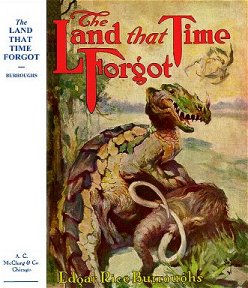
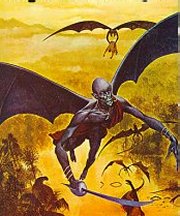
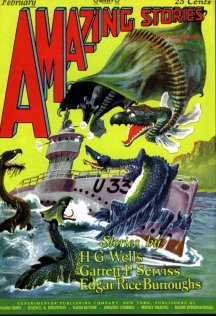
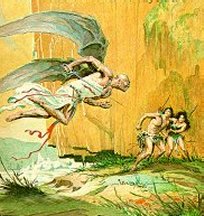
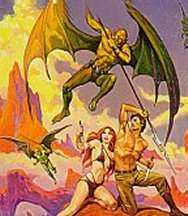
![]()
![]()
![]()
![]()

![]()